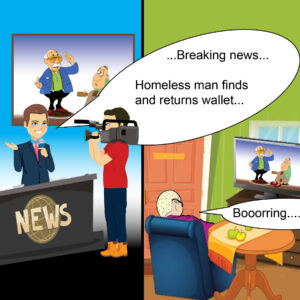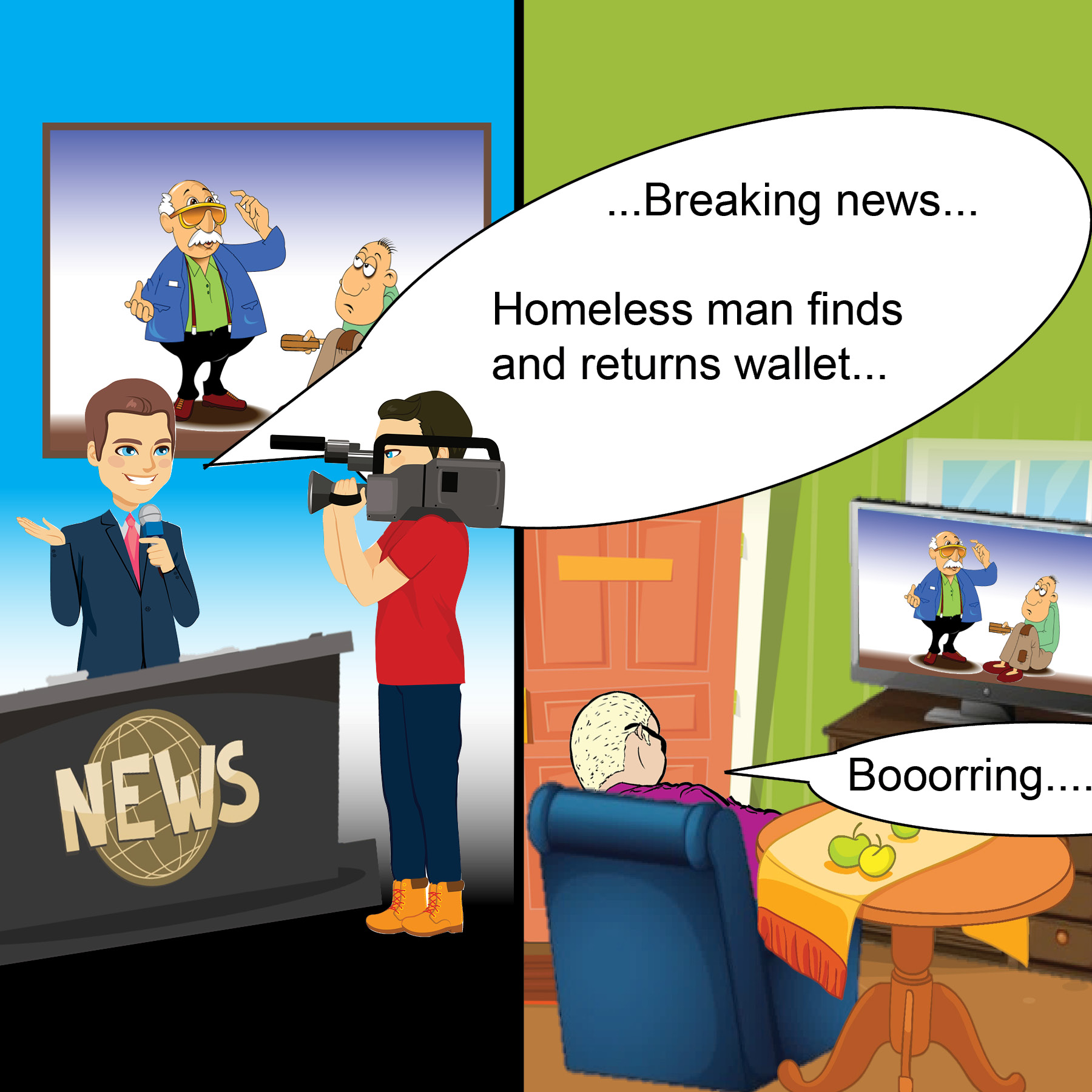By Jeremy Reynalds, Ph.D.
Founder and CEO
Joy Junction Inc.
 By the way some people react to the homeless, you’d think they believe they’re equivalent to a basket of deplorables, as well as being similar in nature to a religious group once dismissively described as largely poor, uneducated and easy to command.
By the way some people react to the homeless, you’d think they believe they’re equivalent to a basket of deplorables, as well as being similar in nature to a religious group once dismissively described as largely poor, uneducated and easy to command.
While there are many wonderful, caring and giving people nationally who care deeply about the poor, homeless and hungry, we have more than a few who don’t hesitate to make thoughtless and mean spirited judgments about the homeless. Here’s a local example.
So what’s your perception of the homeless? Is it shaped by actual hands on experience such as volunteering at a local shelter, or does it depend on what you see on the media-both local and national?
I suspect that much of your thinking is influenced by media. If that’s the case, how the media portray the homeless is incredibly important.
Just over a decade ago, I wrote my doctoral dissertation on the media’s portrayal of the homeless.
I analyzed how the media informally educate their audiences, interviewed homeless people and journalists, and conducted content analysis of news stories. I found that homelessness is not a media priority because it does not provide the requisite ratings boost. My findings then are still relevant today.
Ratings are very important to TV news.
With that in mind, we asked some of our guests at Joy Junction this question. “When talking about homelessness, do you think the way that local and national media share the experience of homelessness is typical of your plight? If not, what could they do better?”
Those to whom we talked weren’t shy about sharing their feelings.
One guy said that when there’s a story about the homeless featured in the media, there’s a certain mind set at work.
He continued, “It is usually about their agenda or motives on what they want their audience to hear, and how they want the people to feel about a certain subject.”
I never heard that discussion when I worked and interned for a while in local newsrooms years ago. What I did see was committed journalists doing their best to tell correctly a difficult story sometimes still unfolding, and a desire to be the first to get the story on their air.
Returning to the guy who believes the media have a certain mind set. He said he doesn’t know what they could do better, but wished there would be more positive stories.
“Why are they not focusing on the good things that the homeless are doing like resolving their addiction, families becoming productive citizens and giving back by volunteering their time and money to help others, and becoming college graduates?”
Another woman said the way the media portray the homeless is far from typical of their plight.
She continued, “The local and national media often portray people that are homeless as a burden on society … The homeless are considered worthless, and need to be hidden from the world or locked up.”
One guy said media portrayal of the homeless is typically as drug addicts. And some people, he said, are homeless due to unfortunate circumstances occurring in their lives.
He added, “A while back the homeless people were getting hurt and even killed and blamed for all the negativity that was going on in the city.”
One man commented that if a homeless man shot a cop, the headlines would read “homeless man shoots cop.”
However, the man continued, if a city resident shot a cop, the headline would say, “Albuquerque man shoots cop.
“To me the media are only interested in how to get high ratings, and not in the actual event taking place.”
An anchor I spoke to a number of years ago said that what happens everyday and works out okay isn’t news.
“It’s some of the negative things that happen that tend to get our attention. And the homeless probably get more negative comments than many because they tend to be more desperate, they may be on drugs or alcohol, and we tend to zero in on some of the actions they’re responsible for that aren’t so good.”
There’s another good reason why the media are generally not more positive. Let me explain.
In one experiment people chose stories with a negative tone when asked what sort of political stories they liked.
But when asked, individuals in another experiment said they preferred good news.
People have shown they liked negative stories, and you have to give the viewers what they want. It is the news “business.” Follow the money trail. At a corporate level, it’s all about ratings. Why? Because higher ratings mean advertisers can be billed higher rates.
Reporters (who begin their career with a vision of changing the world but are brought back to the realities of commercial television news pretty quickly) and news directors may not like it, but that’s the way it is.
So even with the current ratings constraints, is there still a way to get a more accurate perspective about the homeless?
One woman said, “Speak with the people at the shelters, and find out how and why some people became homeless. Not everyone loses everything they own because of an addiction.”
Another woman agreed. “The media needs to actually speak to the homeless population and find out the reality of their homelessness. Society has the wrong image of homelessness because of the media.”
One person went even further, saying the media “could sell everything they have and give to the poor, and then come and live among the homeless for awhile, so they could see the truth for themselves.”
The anchor I referred to before questioned the point of doing that, as he wouldn’t do so with anyone else.
He added, “I don’t want to sit around a campfire with you and exchange stories and feel sorry for you. That’s just the way it is. And one thing we need to remember is that journalists are people, and in general they’re pretty smart people, and they’re skeptical and they don’t want to be scammed-like the rest of the population.”
He continued, “Accountants and plumbers and fire fighters and police officers could be asking the same thing. In many ways, they deserve just as much time as the homeless do. Just because of our business, we don’t spend a whole lot of time with any particular group.”
One guy said the media could help “by promoting more jobs that are becoming available for the homeless, (and encouraging) programs that would allow the homeless to rise up and become more productive.”
But should the media advocate for a cause or plight of a marginalized people group?
Although it’s happened recently, it’s still a controversial topic.
As Thomas Fuller said in a piece he wrote for the New York Times, “Advocacy is a longstanding taboo in American journalism, making reporters and editors wary of discussing solutions to the problems they highlight in their coverage. One rationale for this is that journalists who advocate causes might be selective in their reporting or biased in their coverage.”
As to whether the media are obligated to cover the homeless at all, a photojournalist I interviewed for my dissertation reminded me that network news coverage-local and national-is advertising and ratings driven.
“A lot of people would say, ‘We’re not advertising to the homeless. I’ve actually heard management say things like that. We’ve got a paying viewing public and we need to advertise to them.”
So like any good consumer, do your due diligence. That involves viewing comparisons between local network news affiliates (if it’s the plight of your area’s needy that particularly interests you), and seeing what (if any) coverage of the homeless emerges.
If you don’t like what you find, contact the newsroom and send a polite email, asking why there is not more coverage of the area’s homeless and hungry. While many people vent (often irrationally on social media about what they don’t like), far fewer people actually take the time to put together a thoughtful note to a news director or reporter expressing a concern or asking an question.
Due to issues often beyond local control, you may not get the answer you want, but at least they’ll know someone with an interest in local homelessness and hunger issues is concerned enough to get in touch. If they get enough emails or notes, policies could be changed.
However, the best way to see what the homeless are really like and what’s going on with need in your city is to visit a local shelter or soup kitchen. Even the best TV news segment can only give a snapshot in time of an issue, so hands on involvement (eating the three course meal as opposed to just the appetizer) is the way to go.
As you think about these issues, I hope you’ll consider Joy Junction as a place to get involved. We’d love to have you.


